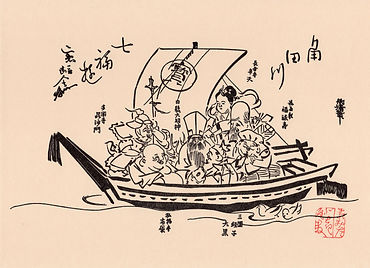Sumidagawa Seven God of Fotune
Mimeguri-shrine

Koufukuji-temple
Shirahige-shrine
Tamonnji-templeBishamonten
Mukoujima
HyakkaenHukurokujyu
The Sumidagawa Seven Gods of Fortune are said to have been proposed by cultured individuals who had gathered in Mukojima Hyakkaen from 1804-1818.
In memory of the ceramic statue of Fukurokuju held by Sahara Kikuu, the owner of Mukojima Hyakkaen, it is said that the Seven Gods of Fortune,
which include Bishamonten, the God of warriors(Tamonji Temple),
Jurojin, the God of long life (Shirahige Shrine),
Fukurokuju, the God of health, happiness, and longevity (Mukojima Hyakkaen),
Benzaiten, the Goddess of knowledge, art, and beauty (Chomeiji Temple),
Hoteison, fat and happy god of abundance and good health(Kofukuji Temple),
Ebisu-shin, the God of fishers or merchants,
Daikoku-shin, the God of wealth, commerce, and trade (Mimeguri Shrine),
were brought together as a means of entertainment and worship during the New Year Holidays.
In 1898, the people of Mukojima Island involved Enomoto Takeaki and his associates to create a Seven Gods of Fortune group who would go on to establish at 4km pilgrimage route for the Seven Gods of Fortune. In 1908, guide stones of a painting by a key government official at the time of the Seven Gods of Fortune were established and even today the guide stones are enjoyed by many who come on pilgrimage. The statues of the Seven Gods of Fortune can be seen only from January 1 – 7.









